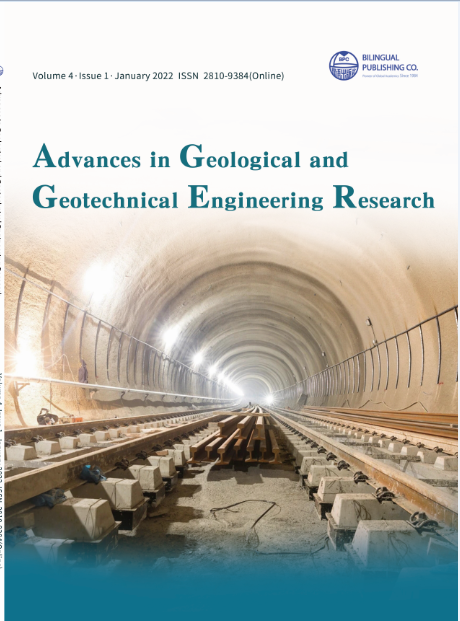-
854
-
688
-
557
-
535
-
484
Climate Change Impacts on Water Resource and Air Pollution in Kabul Sub-basins, Afghanistan
DOI:
https://doi.org/10.30564/agger.v4i1.4312Abstract
This Climate Change Impacts on Water Resources and Air Pollution,research is carried out to analysis Hydro-meteorological and groundwater data in Kabul Sub-basins, Afghanistan. The main objective of this research is to find out natural causes of climate change effects on surface and to,groundwater resources and air pollutions, these data are collected from diferent Hydrometeoroiogical stations and observations in Kabul Subbasins for different years (1957 to 2017). For completion this research they used two categories of data analysis; one is hydro meteorological analysis,and the other is groundwater level analysis. In hydro meteorological analysis air temperature, rainfall and discharge have been recovered by this research in Kabul Sub-basins, a number of air temperature, rainfall,discharge of surface water and groundwater are changes due to climate changes from 1957 to 2017. For climate changes effects this article used air pollution data of national, international development bank of Asia,WHO standards and parameters; PM2.5, PM10, TSP, NO2, SO2, O3, CO and Pb. From comparing PM10 are very higher in the air of Afghanistan. The discharge of Panjsher river due to glacier melting and climate changes increasing. The challenges during this research are lack of equipment.
Keywords:
Groundwater, Hydrometeorological data, Climate change, Air pollution, PMReferences
[1] Abdul Wahab Azad, 2015. Solid waste management in Kabul city of Afghanistan. New Delhi,India, Available (25 March 2019) on https://www.Academia.edu/12919045/solid
[2] Afghanistan Cement industry, 2017. Afghanistan cement industry, Kabul Afghanistan.
[3] Annual Statistics, 2016. The Central Statistic Organization, No 37, Central Statics Press. pp.9.
[4] Arian, H., Kayastha, R.B., Bikas, C.B., Ahuti, S.,Rasouli, H., Armstrong, R., 2015. Application of the Snowmelt Runoff Model in the Salang River Basin,Afghanistan Using MODIS Satelite Data.Journal of Hydrology and Meteorology, Vol. 9, No.1, SOHAM,Nepal.DOI: https://doi.org/10.3126/jhm.v9i1.15586.
[5] Arez, Ghulam, 2002. Kabul City in the Decades, Akbar Organization. pp. 44.
[6] Brunekreef, Bert, Holgate, Stephen, 2002. Air pollution and health. Journal of the Lancet. Vol. 360, No. 9,1233 - 1242.DOI: https://doi.org/10.1016/S0140-6736(02)11274-8.
[7] Bartaud Alain, 2005. Kabul Urban Development Current City Structure, Spatial Issues,Recommendation of Urban Planning. pp. 3.
[8] Belhassan, K., 2020. Hydrogeology of the Ribaa - Bittit springs in the Mikkes Basin (Morocco). International Journal of Water Resources and Environ-mental Science. 9(1), 07- 15. ISSN 2311 - 2492, ©IDOSI Publications, 2020. https://www.researchgate.net/profile/Kaltoum-Belhassan-2/publication/344401861_Hydrogeology_of_the_Ribaa-Bittit_Springs_in_the_Mikkes_Basin_Morocco/links/5f79f1f4a6fdcc008655a421/Hydrogeology-of-the-Ribaa-Bittit-Springs-in-the-Mikkes-Basin-Morocco.pdf.
[9] Belhassan, K., 2020. Relationship between River and Groundwater: Water table Piezometery of the Mikkes Basin (Morocco. International Journal of Water Resources and Environmental Science. 9(1), 01 - 06.ISSN 2311 -2492, © IDOSI Publications. https://www.researchgate.net/profile/Kaltoum-Belhassan-2/publication/344401950_Relationship_Between_River_and_Groundwater_Water_Table_Piezometry_of_the_Mikkes_Basin_Morocco/links/61ae09e5ca2d401f27cdb13f/Relationship-Between-River-and-Groundwater-Water-Table-Piezometry-of-the-Mikkes-Basin-Morocco.pdf.
[10] Belhassan, K., 2011. Hydro-geological Context of Groundwater Mikkes and different variations of Its springs flow (Morocco). Research Journal of Earth Science 3(1), 15 - 26, 2011. ISSN 1995- 9044, ©IDOSI Publications, 2011.
[11] Belhassan, K., 2011. Relationship flow-Rainfall in the stream Mikkes (Morocco). Research Journal of Earth Science. 3(1), 39-44. ISSN 1995- 9044, © IDOSI Publications, 2011.
[12] Bartaud Alain, 2005. Kabul Urban Development Current City Structure, Spatial Issues,Recommendation of Urban Planning. pp. 3.
[13] Malkyar, Ghulam, 2017. Air Pollution and its Control. National Environmental Organization, Head of Government Source. pp. 1-8.
[14] National Environmental Organization, 2012. The first national report of Afghanistan for International Convention Climate Change. pp. 37-77.
[15] Rasouli, H., Safi, A.G., 2021. Geological, Soil and Sediment Studies in Chelsaton Sedimentary Basin,Kabul, Afghanistan. International Journal of Geosciences. 12, 170-193.DOI: https://doi.org/10.4236/ijg.2021.122011.
[16] Rasouli, H., Sarwari, M.H., Khairuddin, R., Said,A.H., 2020. Geological Study of Tangi Mahipar Mountain Range along Kabul Jalalabad road, Afghanistan .DOI: https://dx.doi.org/10.4236/ojg.2020.1010044.
[17] Rasouli, H., 2020. Application of soil physical and chemical parameters and its Comparing in Kabul Sedimentary basins, Kabul, Afghanistan. https://www.researchgate.net/profile/Hafizullah-Rasouli/publication/339927350_15639-A-2020APPLICATION_OF_SOIL_PHYSICAL_AND_CHEMICAL_PARAMETERS_AND_ITS_COMPARING_IN_KABUL_SEDIMENTARY_BASINS_KABUL_AFGHANISTAN/links/5e6c8c1192851c6ba700b96f/15639-A-2020APPLICATION-OF-SOIL-PHYSICAL-AND-CHEMICAL-PARAMETERS-AND-ITS-COMPARING-IN-KABUL-SEDIMENTARY-BASINS-KABUL-AFGHANISTAN.pdf
[18] Rasouli, H., Qureshi, R., Belhassan, K., 2021. Investigations on River Sediments in Chak Sedimentary Basin, Wardak Province, Afghanistan. Journal of Geological Research, 3(4), 21-29.DOI: https://doi.org/10.30564/jgr.v3i4.3574.
[19] Rasouli H., 2021. Analysis of Groundwater Quality in Jabal Sarage and Charikar Districts,Parwan,Afghanistan. Journal of Geological Research, 3(4),45-55.DOI: https://doi.org/10.30564/jgr.v3i4.3717.
[20] Rasouli H., 2019. A STUDY ON SOME RIVER SEDIMENTS, HYDROLOGY AND GEOLOGICAL CHARACTERISTICS IN CHAK SEDIMENTARY BASIN, WARDAK,AFGHANISTAN. International Journal of Geology, Earth & Environmental Sciences, ISSN: 2277-2081, and Open Access, Online International Journal Available at http://www.cibtech.org/jgee.htm2019Vol.9(2)May-August,pp.49-61/Rasouli.
[21] Rasouli, H., Shamal, S., Sarwari, M.H., 2021. Geological Study of Dasht-e-Top Sedimentary Basin, Wardak Province, Afghanistan. International Journal of Geosciences. 12, 531-540.DOI: https://doi.org/10.4236/ijg.2021.126029.
[22] Shamal, S., Rasouli, H., 2018. Comparison between pH, EC, CaCO3 and mechanical analysis of Qala Wahid and Company Areas soil, Kabul, Afghanistan. International Journal of Science and Research, volume 8 Issue 5. https://www.researchgate.net/profile/Hafizullah-Rasouli/publication/337048872_Comparison_between_pH_EC_CaCO3_and_Mechanical_Analysis_of_Qala_Wahid_and_Company_Areas_Soil_Kabul_Afghanistan/links/5dc241aea6fdcc2128088f82/Comparison-between-pH-EC-CaCO3-and-Mechanical-Analysis-of-Qala-Wahid-and-Company-Areas-Soil-Kabul-Afghanistan.pdf
[23] Rasouli H., 2020. WELL DESIGN AND STRATIGRAPHY OF SHEERKHANA DEEP WELL IN CHAK DISTRICT, WARDAK, AFGHANISTAN.International Journal of Geology,Earth &Environmental Sciences ISSN: 2277-2081, and Open Access,Online International Journal Available at https://www.cibtech.org/jgee.htm
[24] Rasouli, H., Kayastha, R.B., Bikas, C.B., Ahuti, S.,Arian, H., Armstrong, R., 2015. Estimation of Discharge From Upper Kabul River Basin, Afghanistan Using the Snowmelt Runoff Model. Journal of Hydrology and Meteorology. SOHAM, Nepal. Vol. 9,No.1.DOI: https://doi.org/10.3126/jhm.v9i1.15584.
[25] Safi, A., Wafa, W., 2014. Ozone and Environment.Scientific Journal of Kabul University. 4, 58.
[26] Safi, A., 2017. Atmosphere and Ozone. Scientific Journal of Kabul University. 2, 1-9.
[27] Safi, L., Safi, A., Ghafori, A., 2012. In Kabul City without Houses Problems, National Center for Policy Research, Kabul University, Noori Printing Press. 70.
Downloads
How to Cite
Issue
Article Type
License
Copyright © 2022 Hafizullah Rasouli

This is an open access article under the Creative Commons Attribution-NonCommercial 4.0 International (CC BY-NC 4.0) License.




 Hafizullah Rasouli
Hafizullah Rasouli





